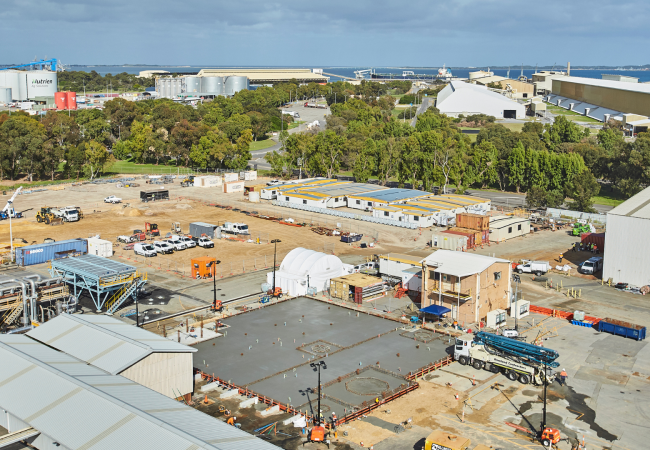Last week the Sodium Cyanide (SCN) Plant Expansion project team achieved an early milestone in the construction phase of the project after only recently completing the engineering phase of the project – a huge milestone in itself.
“The project is focused on debottlenecking and modernising the existing plant and improving critical infrastructure, all while maintaining safe and continuous operations,” Project Manager Major Projects,” Greg Samuels said, “Moving from engineering and design to construction phase isn’t just an engineering milestone — it’s the turning point where concept becomes construction.”
Whilst there has been weeks of construction preparation already, a key component in the construction phase took place last week when SCN team members and civil contractors West Coast Civils (WCC) were on site to complete the Reverse Osmosis (RO) Slab Pour, which required 400m3 of concrete to be poured in under five hours.
Over 30 personnel were involved in the job, which utilised 63 truckloads of cement and two concrete pumpers – with the slab pour being as successfully completed by 8:30am.
Demand for SCN in the gold industry – a recap
It was announced earlier this year that the Sodium Cyanide (SCN) plant will increase production by more than 30% through the current Plant Expansion project.
At the last Kwinana WesCEF team BBQ, General Manager Sodium Cyanide & AV/ModWood, Barney Jones and General Manager Major Projects David Zacher shared an update on the increasing demand for SCN and progress on the Expansion project so far.
WA is a global leader in gold production, producing nearly two-thirds of all the gold mined in Australia, so demand for SCN in WA alone, maintains a health demand.
Australia overall is the third-largest producer of gold in the world, accounting for around 10% of global output and with gold sitting at over $6,000 AUD/oz – more than double what it was three years ago – efforts in mining gold continues to grow.
“With the gold price at such a high, mines are striving to produce more gold, whether that’s by expanding their current mines or developing new mines … and that’s where the AGR team come in.” General Manager Sodium Cyanide & AV/ModWood, Barney Jones, said.
Sodium Cyanide is critical to the gold mining process, and more gold mining means more demand for SCN.
Last year AGR sold 54,000 tonnes of sodium cyanide solution to local mines. This is forecast to increase to 73,000 tonnes within the next few years, and likely to grow well beyond that as we move to 2030 due to an increased need for SCN in processing low grade ore, as well as more gold mining projects coming online.
“54,000 tonnes was easily a record for us, so to be in a place where we think that will increase by over a third in just a few years is really incredible.” Barney said.
What does the SCN Plant Expansion project involve?
The Expansion project is not only focusing on increasing production capacity but also how the plant operates technically, developments in process safety, improvements on the sustainability front and forecast future capacity.
Firstly, there is a significant technical change in how SCN will be produced, which will align the plant more with the ammonia and nitric acid plant configurations, but incorporates hydrogen cyanide, or HCN. The use of HCN does pose safety risks and this is being addressed in the expansion design in addition to updated process safety management in the plant.
The expansion will also see improved water efficiency and a reduction in emissions due to a new incinerator processing start-up process gases, reducing the emissions released to the atmosphere.
“I’m pleased to say this expansion is set to deliver a nearly 30% reduction in emissions intensity. It also improves our water efficiency by cleaning and recycling the water back into the cooling towers. That’s a direct result of smart design and new technology being brought into the process.” General Manager Major Projects, David Zacher said.
The project will see an increase in capacity across both the liquids and solids plants, with the liquids plant (SCP1 and SCP2) increasing by over 30%, from 94,000 tonnes per year to 130,000 and the solids plant (SCS) increasing from 46,000 to 60,000 tonnes per year.
A new, higher-capacity thermal oxidiser will help keep overall emissions at current levels, even as production increases, whilst a new incinerator will be installed with the assistance of a $7.5 million Federal grant, which will help reduce the plants’ carbon footprint.
“This is a major project — it’s about more than increasing production. It’s about setting a new benchmark for safety, for emissions performance, and for how we grow sustainably.
Thanks again to everyone, from across the business, who’s been involved and supported this project to date. It’s been a mammoth task, but I’m really proud of the team and can’t wait to see it continue to progress.” David said.
Keep up to date here or via AGR’s website.

